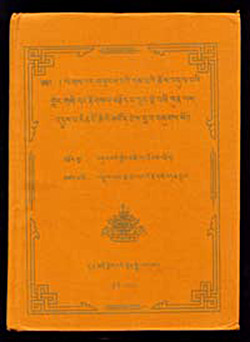by José Ignacio Cabezón and THL.
The Vinaya

The first folio of the first text of the Vinaya, the Vinayavastu, in the Tibetan Buddhist canon, the KangyurBka’ ’gyur.
In the first centuries after the Buddha’s death, all of the traditions associated with the monastic rules came to be codified and systematized in the into an oral – and eventually a literary – corpus of materials that came to be known as the Vinaya (Dülwa’Dul ba), from a verbal root meaning “to discipline.” Thus, in time, the Vinaya came to refer to a collection of texts that, taken as a whole, form one of the three major subdivisions, or “baskets” (denösde gnod), of the Buddhist canon.16
Different Buddhist traditions in different Buddhist countries have slightly different Vinayas that were derived from different sects of Indian Buddhism. For example, Theravāda Buddhists follow the Theravāda Vinaya, Chinese Buddhists follow the Mahāsāṃghika vinaya, and Tibetan Buddhists follow the Mūlasarvāstivāda vinaya. The fact that there is considerable unanimity of opinion between these various traditions suggests that the codification of the monastic discipline probably took place at a relatively early date.

A Tibetan commentary on the Vinaya (Nidāna) by the First Dalai Lama.
The Tibetan Vinaya as a corpus of literary texts takes up thirteen volumes of the 103 volumes of the Tibetan Buddhist canon (KangyurBka’ ’gyur).17 In addition to these texts, which the Tibetan tradition considers to be the Buddha’s actual words, there is a substantial Indian commentarial literature on the Vinaya found in the commentarial portion of the Tibetan canon (called the TengyurBstan ’gyur).18 Finally, there arose in Tibet over the centuries a voluminous native Tibetan literature on the Vinaya: both commentaries (drelpa’grel pa), and the textbooks (yikchayig cha) that formed the basis for the study of the discipline in the monastic academies. The Vinaya is one of the five major subjects of the GelukDge lugs educational curriculum, and monks who reach this point in their studies spend several years solely on these texts – memorizing, studying and debating their meaning. Anyone who wishes to study the monastic discipline as an academic subject has to possess full ordination. Since the geshédge bshes degree requires the study of Vinaya, this means, effectively, that only fully ordained monks could become geshésdge bshes.19
People Home
Table of Contents
- What is a Monk?
- The Vows
- The Vinaya
- Hierarchy and Status
- Contemporary Distinctions
- Demographics
- The Sera Monks Archives
- Glossary
- Notes
- Specify View:
- Specify Format:
 |  |  |